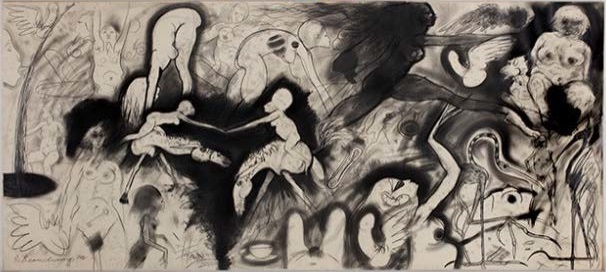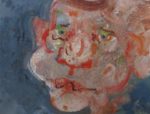
Robert Beauchamp
American, 1923-1995
Untitled #9, 1972
ink and watercolor on paper
36 x 80 in.
SBMA, Gift of Bronya and Andrew Galef
2017.40

Self Portrait , 1974
COMMENTS
Beauchamp's early work established him as an important Figurative Expressionist, a movement that emerged from Abstract Expressionism. His early paintings contain all of the basic tenants of modernist mastery, some of which was imparted to him by the great teacher/artist Hans Hofmann. However, while Hofmann's method of teaching focused on non-representational formalism, during the mid-fifties some of his students including Beauchamp, Jan Muller, Lester Johnson, and George McNeil, abandoned abstraction to develop figural formalism.
Towards the end of the 50's more and more young artists both in Provincetown and New York City started to paint in this mode. Their artwork became more indicative of an emotional response to the collective experience of the world around them, than the abstract constructs. However, many critics who were heavily influenced by the outspoken force that was Clement Greenberg, naively ignored this movement.
Instead of receiving their credit as revolutionary modernists, the East Coast Figurative Expressionists were overshadowed by their Ab Ex contemporaries and superseded by Pop Art and Minimalist art in the sixties. However, it is clear when looking at the vast body of work that Beauchamp and his contemporaries created throughout the sixties and seventies, and into the last decade of the 20th century; the Figurative Expressionists were the last great American modernist painters.
In the work from the late 50's, 60's, and 70's, Beauchamp's figurations contort and dance around the canvas. Viewers enter a world of mystical imagination both primitive and intellectual, where yearning for an extreme realm of otherworldly existence is stimulated. His blending of the figure and the ground and his gestural application of paint show that Beauchamp mastered Hofmann's Push and Pull technique, as well as the action painting process that critic Harold Rosenberg coined to associate with Abstract Expressionists. In the last two decades of his life, Beauchamp began to express the human figure in a very distinct and more blatantly personal manner than previously. His progression showed that as an artist he remained responsive at all times. Beauchamp is a testament that expression and emotion, both experienced and imagined, are most powerful when they arise out of the spontaneous application of paint.
- Adam Zucker, Robert Beauchamp's Animalia, ACME Fine Art in Boston, Dec 17, 2009
http://www.berkshirefinearts.com/12-17-2009_robert-beauchamp-s-animalia.htm
SBMA CURATORIAL LABELS
Robert Beauchamp (pronounced Bee-chum) studied painting and drawing with Boardman Robinson at the Colorado Springs Art Center and pottery at the Cranbook Academy of Art in Michigan before working with Abstract Expressionist Hans Hofmann in Provincetown and New York. He moved to New York in the early 1950s and was involved with the Tenth Street Galleries, becoming affiliated with the second wave of Abstract Expressionists, including John Grillo, Lester Johnson, George McNeil, and Jan Muller.
In 1953 he gave up abstract art, believing it to be too esoteric and remote from immediate life, and returned to painting the figure. From 1953-1957, he began to populate his work with anthropomorphic creatures, which he called Beauchamps, that seem to spontaneously emerge from his working process. He rejected symbolic interpretations of these figures, preferring that the viewer see them as improvisational and ambiguous.
- Summer Nocturne, 2018
